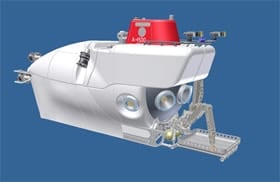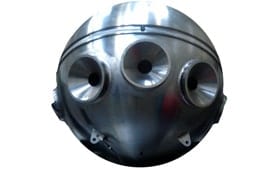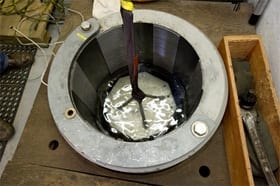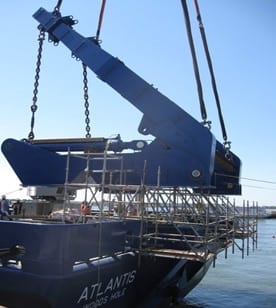HOV Alvin Upgrade Progress Report
January 2012
In 2004, Woods Hole Oceanographic Institution (WHOI) received funding from the National Science Foundation (NSF) to design and build a new, state-of-the-art 6500 meter research submersible to replace the HOV Alvin that has served the U.S. science community so reliably for the past four decades. After reviewing detailed cost estimates for design and construction of the new vehicle, WHOI recommended an alternative, less costly path consisting of fabrication of the 6500 meter personnel sphere, followed by its integration with Alvin’s existing systems.
Stage 1 of this process is now underway, and the new personnel sphere will be integrated into Alvin’s modified frame. This new sphere allows for larger fields of view for scientists, including complete overlap with the pilot’s view of the deep ocean and seafloor, thereby providing significant improvement over the existing Alvin’s capabilities. In addition, the upgraded vehicle will have fiber optic penetrators, improved ergonomics, a new command and control system, improved lighting and imaging, increased data logging capabilities, and better interfaces with science instrumentation. The two major goals that will not be accomplished during Stage 1 are an increased depth capability (since some of Alvin’s systems to be used are only rated to 4500 meters), and increased energy availability that would provide longer duration dives and enhanced mid-water capabilities. In order to provide more energy, a different battery type will be required. Once this developing technology matures to ensure its safe use in human-occupied vehicles, and as funding becomes available, Stage 2 will make the changes necessary to increase working time and extend the depth rating of the submersible to 6500 meters.
Vehicle Components Status
All new syntactic foam, designed to withstand pressure at depths of 6500 meters, has been purchased, tested, and accepted. Currently, the foam is being shaped for use on the vehicle. In addition, the new electrical and fiberoptic penetrators, which are the through-hull fittings allowing communications between the inside and outside of the sphere, are being delivered and tested, and the frame has been vendor qualified and selected, with a design review scheduled for early January.
Disassembly of the current Alvin began in January 2011. Systems that will be retained from Alvin, which include the variable ballast, hydraulic, and mercury trim, have been refurbished ready to be reinstalled. Prototype equipment is being installed in a fiberglass mock-up of the sphere, and a mock-up of the frame is being used to ensure fit of components once the modified frame is returned to WHOI.
R/V Atlantis Modifications
The ship’s handling system is also undergoing major modification and overhaul. The A-frame was strengthened and upgraded in spring of 2011, and the swinging beam assembly has been shipped to the manufacturer for upgrade. Integration of all components and classification by the Naval Sea Systems Command (NAVSEA) and the American Bureau of Shipping (ABS) is scheduled for summer 2012.
Challenges
There are several challenges with the upgrade project. The most significant is that NSF directed WHOI to obtain both NAVSEA certification and ABS classification for the submersible. NAVSEA was added as a required certification after construction of the sphere had begun, and each certification agency has different guidelines. This dual certification has increased the project's complexity, impacting cost and schedule.
Major Project Milestones
System assembly and testing will begin in spring 2012 and will be completed in September. Testing of the vehicle at the dock will begin in the fall, and sea trials will be conducted before the end of 2012.




